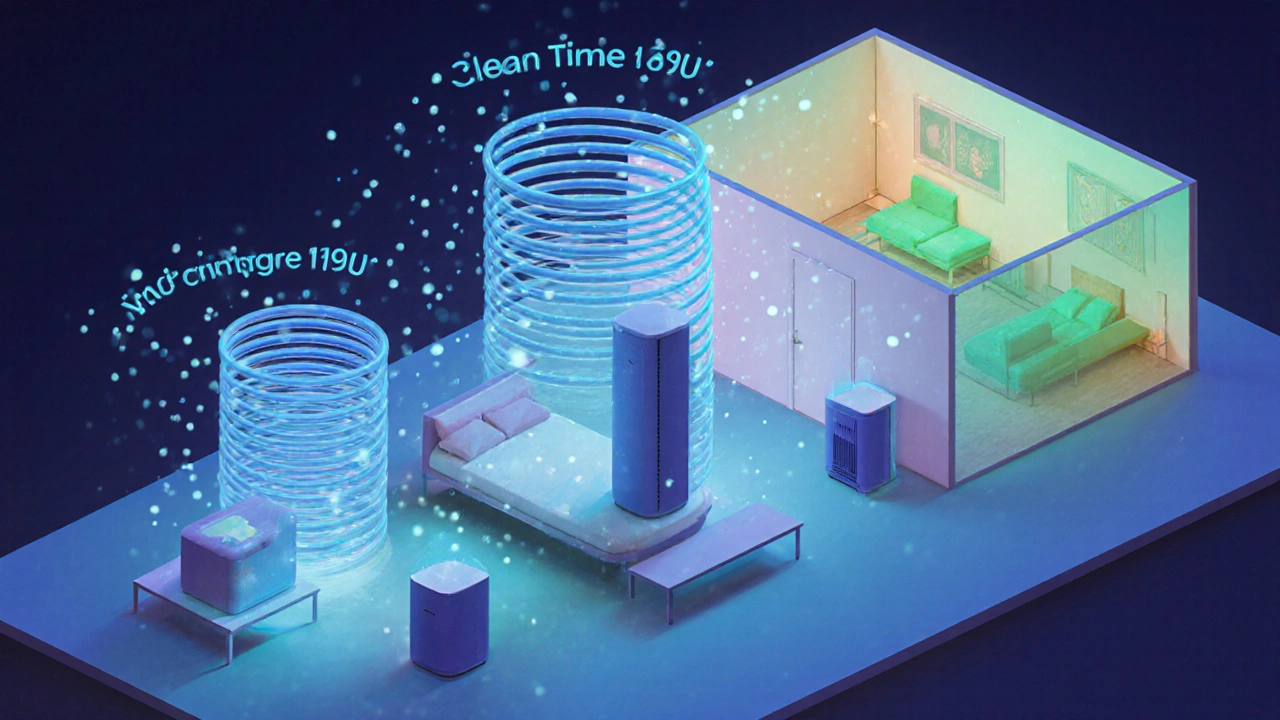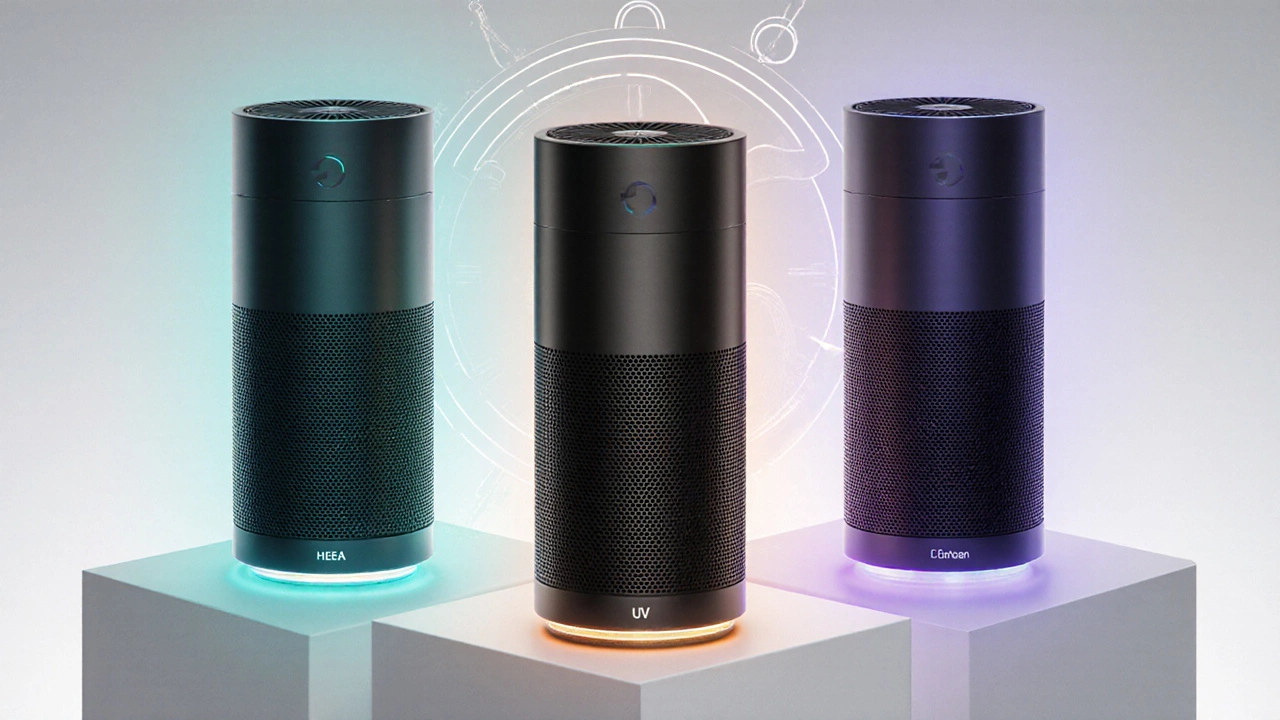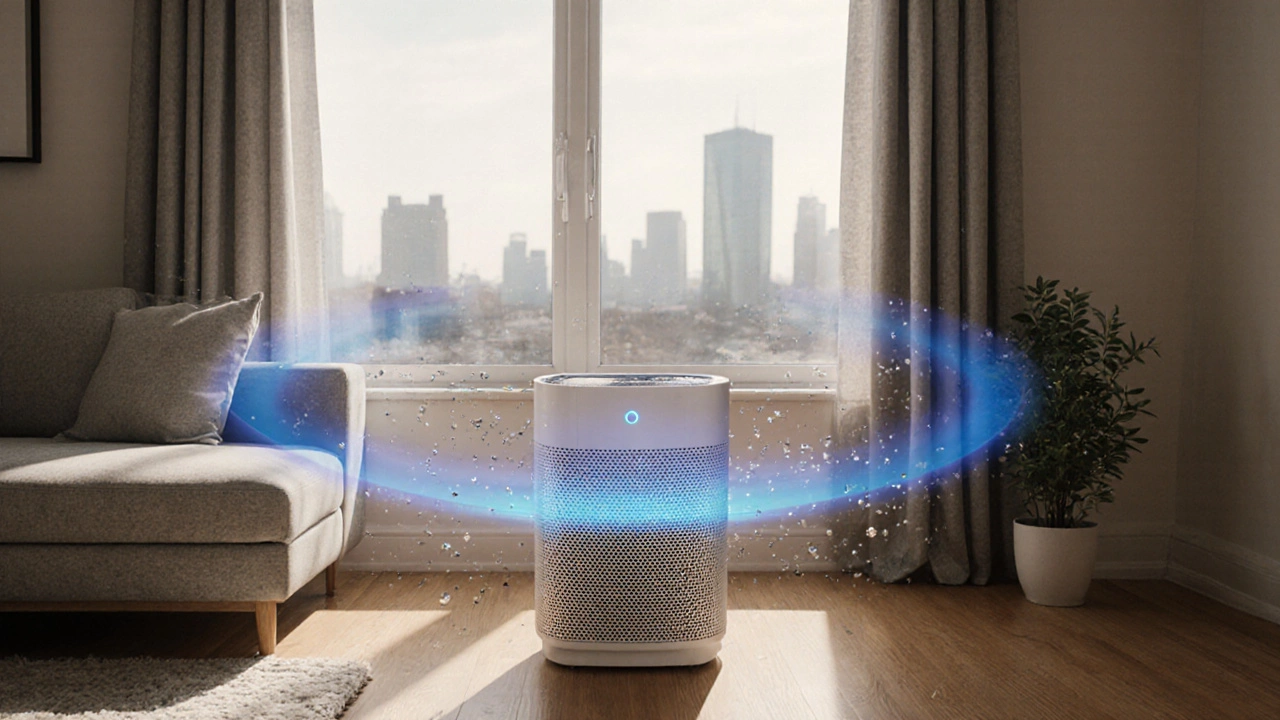Air Purifier Clean Time Calculator
Enter Your Room Details
Estimated Clean Time
Calculation: Room Volume (ft³) ÷ CADR (CFM) = Minutes per Air Change × ACH = Total Clean Time
ASHRAE recommends 2-4 ACH for healthy indoor air quality.
When you set up an air purifier is a device that draws indoor air through filters to capture particles, gases, and odors, the first question that pops up is: how long before the room actually feels fresh? The answer isn’t a one‑size‑fits‑all number; it hinges on a handful of measurable factors that you can calculate yourself.
Key Takeaways
- Clean time depends on the purifier’s Clean Air Delivery Rate (CADR) and the room’s volume.
- Most modern units need 2‑4 air changes per hour to bring indoor air quality down to a healthy level.
- HEPA filters remove >99.97% of particles ≥0.3 µm, while activated carbon tackles odors and VOCs.
- Smart sensors can auto‑adjust fan speed, shaving minutes off the total run time.
- Keeping doors closed and placing the purifier in the room’s center speeds up circulation.
Understanding What “Clean Time” Means
In the industry, air purifier clean time is often expressed as the period needed to achieve a specific reduction in airborne pollutants, usually measured as an Air Quality Index (AQI) drop of 30‑50% or an equivalent number of air changes per hour (ACH). The concept is similar to how many times a room’s air passes through the filter each hour.
How CADR Drives the Speed of Purification
One of the most reliable specs on a unit’s label is the Clean Air Delivery Rate (CADR). CADR is expressed in cubic feet per minute (CFM) for three particle sizes-smoke, dust, and pollen. Higher CADR numbers mean the purifier can move more clean air, cutting down the time needed to lower pollutant concentrations.
To turn CADR into a usable figure, convert the room’s volume from cubic feet to cubic meters (1 m³ ≈ 35.3 ft³). Then apply the formula:
- Room volume (ft³) ÷ CADR (CFM) = minutes for one air change.
- Multiply by desired ACH (usually 2‑4) to get total clean time.
For example, a 300 ft³ bedroom with a purifier rated at 150 CFM will achieve one full air change in 2 minutes (300 ÷ 150). At 3 ACH, the total run time to reach a noticeable AQI improvement is roughly 6 minutes.
Air Changes Per Hour: The Health Benchmark
The American Society of Heating, Refrigerating and Air‑Conditioning Engineers (ASHRAE) recommends a minimum of 2 ACH for residential spaces and up to 5 ACH for rooms with high pollutant loads, such as kitchens or home offices with a lot of electronics. Each air change dilutes the contaminant concentration by about 63%, so after three changes, you’ve removed roughly 95% of the initial load.
When you know the ACH target, you can directly compute clean time using the minutes‑per‑change figure derived from CADR.

Factoring Room Size, Layout, and Furniture
Room volume is the product of length, width, and height. A typical Vancouver living‑room might be 5 m × 4 m × 2.5 m, equaling 50 m³ (about 1,770 ft³). Larger volumes demand higher CADR or longer run times. Open‑plan layouts aid airflow, while bulky furniture can create dead zones where air circulates slowly.
To mitigate this, place the purifier on a central, unobstructed spot and keep doors closed during the initial purification phase. This helps the unit work on the intended space rather than spilling clean air into adjacent rooms.
Real‑World Examples by Room Size
| Room Type | Volume (ft³) | Typical CADR (CFM) | Minutes per Air Change | Total Clean Time (≈3 ACH) |
|---|---|---|---|---|
| Small bedroom (8 × 10 ft, 8 ft ceiling) | 640 | 200 | 3.2 | ≈10 |
| Medium living‑room (12 × 15 ft, 9 ft ceiling) | 1,620 | 300 | 5.4 | ≈16 |
| Large open‑plan (20 × 30 ft, 9 ft ceiling) | 5,400 | 500 | 10.8 | ≈32 |
These numbers assume the purifier runs at its maximum fan speed. Many models will automatically drop to a lower speed once the AQI reaches the target, extending the overall time slightly but keeping noise low.
Impact of Filter Types on Clean Time
Filters come in several grades. A HEPA filter captures 99.97% of particles 0.3 µm and larger, making it the gold standard for dust, pollen, and smoke. An activated carbon filter adsorbs gases, odors, and volatile organic compounds (VOCs). When a unit combines both, the particle removal happens quickly, but the carbon layer may need more time to soak up lingering smells.
If you replace a standard pre‑filter with a high‑efficiency HEPA unit, you might notice a 10‑15% reduction in clean time because the airflow resistance increases slightly, causing the fan to work a bit harder. Most reputable brands balance pressure drop and airflow to keep CADR numbers realistic.
Smart Sensors and Adaptive Speed Settings
Modern purifiers often embed a smart sensor that measures real‑time particle count and VOC levels. The sensor feeds data to a microcontroller, which ramps the fan up when contamination spikes-like after cooking or a window is opened-and backs off once air quality improves.
In practice, a sensor‑driven unit can shave 20‑30% off the total purification cycle because it avoids running at max speed the entire time. However, this benefit only appears if the sensor is calibrated correctly and the room isn’t excessively large for the unit’s capacity.

Tips to Speed Up Purification
- Close windows and doors while the purifier runs the first 15‑20 minutes.
- Turn off other fans or HVAC that could re‑introduce unfiltered air.
- Keep the filter clean; a clogged HEPA can drop CADR by up to 40%.
- Use the highest fan setting initially, then switch to a lower mode once the AQI drops.
- Place the unit at least 2 feet away from walls to avoid airflow restriction.
Common Misconceptions About Clean Time
Many buyers assume a larger box means faster cleaning, but size alone is misleading. CADR is the true indicator. Another myth is that a purifier can instantly eradicate smoke after a wildfire; in reality, achieving a noticeable drop still takes several air changes, especially in large living spaces.
Finally, some think that running a purifier 24/7 is wasteful. In fact, maintaining a constant low‑level circulation prevents pollutant buildup, meaning the next “deep clean” cycle will be much shorter.
Choosing the Right Purifier for Your Space
Below is a quick comparison of three popular models on the market in 2025. The numbers reflect typical CADR values, filter composition, and estimated clean times for a 12 × 15 ft living‑room.
| Model | CADR (CFM) | Filter Type | Estimated Clean Time (min) | Noise @ Max (dB) |
|---|---|---|---|---|
| PureAir X200 | 300 | HEPA + Carbon | ≈16 | 58 |
| ClearBreeze 550 | 250 | HEPA only | ≈19 | 55 |
| EcoMist S7 | 350 | HEPA + Carbon + UV | ≈14 | 62 |
Pick the model that balances CADR, filter needs, and noise tolerance for the room you plan to treat.
Frequently Asked Questions
What is the minimum ACH needed for a healthy home?
ASHRAE recommends at least 2 air changes per hour for general living spaces. For bedrooms or rooms with pets, aim for 3‑4 ACH to keep dust and allergens low.
Does a higher CADR always mean faster cleaning?
Mostly, yes. CADR measures how much clean air the unit can deliver per minute. However, filter condition, room shape, and airflow obstructions can reduce the effective CADR, so keep filters fresh and place the unit wisely.
How often should I replace the HEPA filter?
Most manufacturers suggest replacement every 6‑12 months, depending on use. If you notice a drop in airflow or a warning light, swap it sooner.
Can I use an air purifier in a kitchen?
Yes, but pick a model with a high smoke CADR and an activated carbon filter to tackle cooking fumes. Position it near the stove but away from direct heat.
Do smart sensors really make a difference?
Smart sensors let the purifier boost speed only when pollutants spike, saving energy and reducing noise during steady‑state conditions. The benefit is most noticeable in variable‑use spaces like living rooms.

